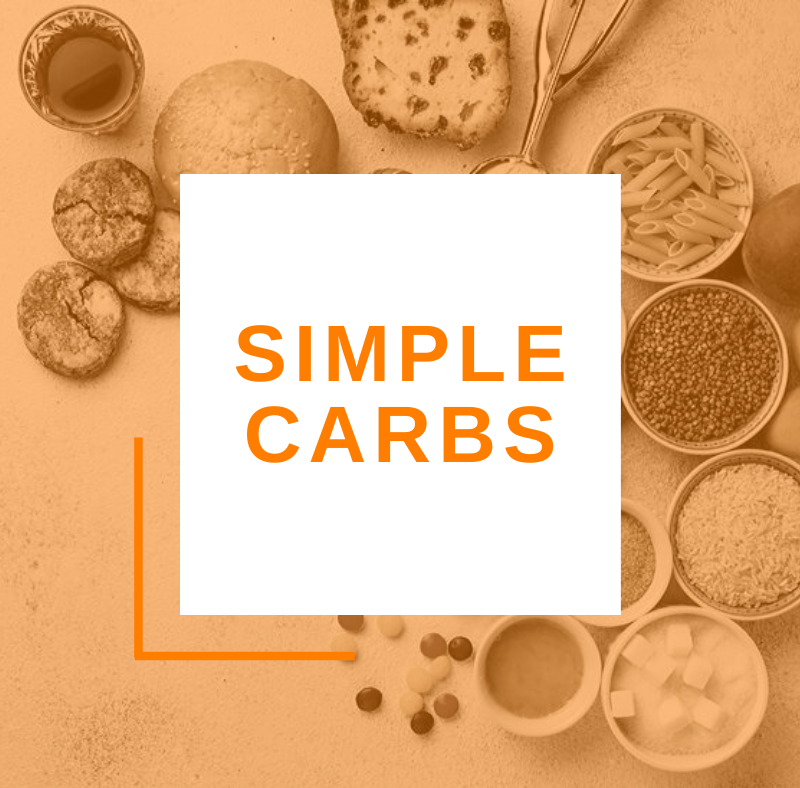
The timing of nutrient intake ranks as one of the most hotly debated issues in fitness. Whether one exercises in a fasted state or post-fueling, carb timing specifically can vary in effectiveness, dependent upon your personal training clients’ goals and personal physiology. Find out the best approach to proper fueling and whether pre- or post-workout carbohydrates are necessary for everyone to consume.
The Physiology of Fueling
Carbohydrate Types
Carbohydrates in the context of human digestion and metabolism can be divided into two basic categories: simple and complex.
Simple carbohydrates are either a single molecule or two molecules, known as mono or disaccharides, respectively.
Complex carbohydrates are also known as polysaccharides, or any unit of three or more interconnected molecules. Some starches and glycogen have multiple branches of many saccharide units put together.
In general, the larger the carbohydrate at a molecular level, the longer it takes to be absorbed. This has several ramifications when comes to diet and exercise, including the insulin secreted and effects on blood sugar levels.
Breaking Things Down
Polysaccharide breakdown occurs until there is a single unit that can be absorbed into the bloodstream. Not all saccharides are equally good at being broken down by the human body. For example, the chemical bond requires the presence of the enzyme lactase, which some do not have, leading to the term “lactose intolerance”.
An insoluble fiber, such as cellulose, will have a beta bond versus an alpha bond. The upshot of this is that the human body produces an enzyme capable of breaking down the molecular bonds of this substance, and instead relies on bacteria in the lower gut to do the job. Methane is a familiar byproduct of these reactions.
Energy from Within
During exercise, hard-working muscles use glucose (readily available) and glycogen (stored sources) for energy. Glycogen stored in muscle cells pulls water inward to increase not only the cell volume but also the fullness within muscle fibers. Research suggests that a greater muscle cell volume can lead to long-term growth.
At some point during an intense lifting session, blood glucose levels and glycogen stores drop so precipitously low that exercise cannot continue. We refer to this state as “going to failure”, that overwhelming sensation of not having enough power/strength to complete another single repetition.
Here, the body begins to secrete the “stress hormone” cortisol, a highly catabolic chemical. Cortisol eats up muscle tissue for protein, converting it into usable glucose. A process called gluconeogenesis ensues, producing glucose from these amino acids in the liver. This results in a loss of muscle tissue.
As we know, strength training causes micro-tears in the muscles’ fibers, and sweating causes the loss of fluids replete with electrolytes. Post-workout nutrients, therefore, take on a critical importance, essential for replenishing muscle glycogen depleted from physical demands. In addition, consuming an exercise recovery meal helps stimulate protein synthesis to repair and build new muscle tissue while restoring fluid and electrolyte balance.
Fuel and Adenosine Triphosphate
“…The best way to get a fire going is providing it with fuel” says David Talley, Wellness Coordinator for Indiana University. In the case of the human body, quality calories equal fuel. Talley explains that fueling up before a workout lays the foundation for a day of improved metabolism, which leads over time to sustained energy.
Emilie Burgess, RDN and board-certified Sports Dietitian (CSSD), echoes this opinion. “Muscle glycogen (the storage form of glucose/carbohydrates in the muscles) is the major source of carbohydrate fuel in the body, followed by our liver glycogen stores, and then blood sugar,” she says. “The glucose or carbohydrates that our body stores or that is within our blood is converted into ATP (energy) within our cells.”
Carb Timing Considerations
Timing, Type, and Duration
The timing of fuel intake, as well as the choice of macronutrients, depends to a considerable extent upon the workout itself. Consider endurance athletes, who rarely, if ever, train or compete in the fasted state. Long workouts (for example, triathlons) demand appropriate fueling for sustained energy. Such athletes tend to opt for a carbohydrate-rich pre-race meal, historically proven to provide the optimal performance advantage.
If one has the luxury of a 2- to 3-hour window of opportunity before a workout, a prudent meal would include a higher amount of carbohydrates, but still some lean protein and “good” fats. Choose a slower-acting carb source, such as oats, whole grains or brown rice. If scheduling only affords the athlete 30-60 minutes before hitting the gym/trails, a fast-digesting carbohydrate source packs the best energy punch. Many cyclists prefer a banana or gel packet (such as “Gu”) to a full meal.
As for post-workout carbohydrate replenishing, meals do not differ too greatly from what bodybuilders choose after a session of heavy lifting. Most experts advocate a meal with a 4:1 ratio of carbohydrates to protein. Some individuals smaller in stature (like many females) opt for a 3:1 ratio.
Breakfast Pre-Workout Fueling or Nay?
The notion of early-morning exercising on an empty stomach has a great deal of appeal, particularly for those athletes with a delicate gastrointestinal system and those who have fully embraced intermittent fasting. Running in particular after having eaten often leads to cramping and bowel urgency. However, outside of this realm, does research document the common assumption of fat loss associated with fasted exercise?
In the absence of food consumption since the evening prior, the human body will rely upon fat stores as the primary energy source for morning workout sessions. While this seems like an easy advantage, the long-term impact just does not play out. Studies comparing athletes who trained fasted versus those who ate breakfast before hitting the gym over the course of one month found no significant difference in fat loss.
Following a typical overnight fast, and in the absence of a bedtime meal, most of us awaken having retained only about 20% of our stored glycogen (which originated as carbohydrates). Once a workout has begun, in the absence of a meal, the body tends to utilize this 20% first and foremost. Yes, before the completion of the exercise, some fat gets burned for energy, but so too will protein and, unfortunately, hard-earned muscle. For some, understanding this concept makes fasted workouts a bit less appealing.
A team from the United Kingdom researched this fasting/fueling debate, and reported their findings in the American Journal of Physiology: Endocrinology and Metabolism. “This is the first study to examine the ways in which breakfast before exercise influences our responses to meals after exercise,” says co-lead researcher Dr. Javier Gonzalez. “We found that, compared to skipping breakfast, eating breakfast before exercise increases the speed at which we digest, absorb, and metabolize carbohydrate that we may eat after exercise.” But that’s not all–the body also will more efficiently access the glycogen stores in the muscle after a breakfast fueling.
Apparently, in “jump-starting” the body’s metabolism with a pre-workout meal, more calories get expended all day long. In fact, some individuals can burn up to 10% more calories, even while at rest.
Mid-Exercise Carb Consumption
Marathon runners and Ironman competitors typically refuel glycogen stores in the midst of an event. Studies revealed that, whether subjects had consumed a pre-workout meal or not, ingesting carbohydrate-rich fuel mid-stride led them to report lower rates of perceived exertion (RPE) throughout the duration of the exercise. Timed trials also improved when carbs were taken while exercising, as compared with individuals who received a placebo. Thus, it would seem that consuming a carb-rich fuel source in the midst of an endurance workout can compensate for having foregone a pre-workout meal.
Some Quick Carb Facts
• Not all carbs are created or structured equally
• Carbs are necessary for the body’s fuel sources and are the body’s primary fuel source
• Carbs do cause a more dramatic insulin response (unlike protein and fats)
• Different types of carbs have different glycemic index values
• Carbs are sources of fiber
• Excessive carb consumption can create health issues and concerns
Carbs are often demonized as making us “fat” (remember, dietary fats received the same reputation decades ago). Carbs are not responsible for making us “fat”. Weight gain (and loss) is not that black and white.
The body is complex and there’s so much happening at the cellular and biochemical level that we cannot visualize or accurately evaluate as fitness professionals. However, we can educate our clients about the value of carbohydrate consumption and the healthiest options and still remain within our scope of practice.
What You Can and Should Do
Sharing general non-medical nutrition information (not advice) is well within the scope of practice for certified fitness professionals. Educating clients about the nutrition label and upcoming changes to it is part of your role.
As a fitness professional, you may do this by providing cooking demos, grocery shipping tips, develop handouts and informational packets (be sure to cite your sources), workshops, seminars, classes, recipe exchanges, or one-on-one with clients. The point is – be creative and communicate nutrition topics to your clients in such a way that it is valuable, relevant, applicable, and timely.

Educating about Carbohydrates
For nutrition guidance and information to be effective, clients do not need to (nor do they want to) know everything there is to know about carbohydrates (or any macronutrient).
Examples of valuable information for you to share with clients include:
• The basic difference between the types of carbs and how they react in the body (including glycemic and insulin response)
• The role carbohydrates have in exercise and general health
• Food sources of each type of carbohydrate and what options are the healthiest
• Evaluating food labels for fiber sources
• Replacement options for less healthy carb sources
Examine this Scenario:
You have a client who brings their food log from the day before and it looks as follows:
Breakfast
- Frosted flakes with 2% milk
- ½ cup unsweetened Blueberries
Lunch
- Large bowl of creamy potato soup with croutons and shredded cheese
- Coffee w/ cream and sugar
Dinner
- Mixed greens with baked chicken (~3 oz)
- Honey Mustard dressing on the side
- Ice water
Snacks
- Goldfish Crackers – 1 package
- Apple with peanut butter
- Rye crackers with Swiss cheese
- Ice water w/ lemon slices
As you evaluate the reported food consumption, here are a few ways that you can suggest changes for a healthier impact:
Breakfast: Suggest that your client add a lean protein and source of good fat. Recommend swapping out the Frosted Flakes for a whole-grain option, perhaps sprouted-grain toast with eggs.
Lunch: Recommend to your client that they eat a broth-based soup instead of a creamy soup, and add more leafy veggies. Skip the coffee cream and sugar, maybe try black and ditch the croutons for a high-fiber slice of bread.
Dinner and/or Snacks: What would you suggest?
There are many different ways to guide a client toward healthier choices. Be sure to consider their preferences when educating them. Habits are easier to adhere to when they are customized to the individual.
References
https://www.healthline.com/health-news/eating-breakfast-burn-more-carbs-when-you-work-out
https://journals.physiology.org/doi/full/10.1152/ajpendo.00163.2018
https://www.sciencedaily.com/releases/2018/08/180815085742.htm
https://www.eatright.org/fitness/exercise/exercise-nutrition/timing-your-pre-and-post-workout-nutrition
https://www.byrdie.com/carbs-before-or-after-workout-5093554
https://www.medicalnewstoday.com/articles/322785
https://health.usnews.com/health-news/blogs/eat-run/2012/09/10/facts-and-myths-about-fueling-up-before-your-workout
https://www.ncbi.nlm.nih.gov/pmc/articles/PMC4042570/
https://www.forbes.com/sites/jennifercohen/2012/05/29/6-ways-to-boost-your-metabolism/?sh=7d0dd7966547
https://theconversation.com/food-for-fitness-is-it-better-to-eat-before-or-after-exercise-18514
https://pubmed.ncbi.nlm.nih.gov/30672619/
www.ncbi.nlm.nih.gov/pubmed/21131864
www.ncbi.nlm.nih.gov/pubmed/17413098
www.inquirer.com/philly/health/sportsmedicine/Post-workout_key_Gummy_bears.html
www.milaonsupplements.com/blog/gummy-bears-post-workout
scholarcommons.usf.edu/cgi/viewcontent.cgi?article=4476&context=etd
www.ncbi.nlm.nih.gov/pubmed/19628104
www.livestrong.com/article/480327-can-i-eat-simple-carbs-post-workout-when-on-a-cut-diet/
freakstrength.com/waxy-maize-starch-versus-dextrosemaltodextrin/
opexfit.com/blog/consuming-sugars-post-workout/
www.bodybuilding.com/content/post-workout-carbs.html
www.verywellfit.com/the-best-foods-to-eat-after-a-workout-3121369







